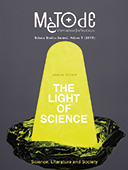El perfil del maltratador machista. ¿Qué nos dice su biología?
DOI:
https://doi.org/10.7203/metode.0.3174Palabras clave:
hormonas, psicobiología, neurociencias, violencia machista Resumen
Resumen
La consideración de los marcadores psicobiológicos de predisposición a la violencia de los hombres que maltratan a las mujeres abre una puerta a la prevención y a la intervención en el campo de la violencia contra las mujeres. Actualmente no disponemos de fármacos efectivos para el tratamiento de la violencia contra las mujeres, pero el desarrollo de programas de intervención psicoterapéutica y de rehabilitación neuropsicológica marca una vía de esperanza.
 Descargas
Descargas
 Citas
Citas
Babcock, J. C.; Green, C. E.; Webb, S. A. and T. P. Yerington, 2005. «Psychophysiological Profiles of Batterers: Autonomic Emotional Reactivity as It Predicts the Antisocial Spectrum of Behavior among Intimate Partner Abusers». Journal of Abnormal Psychology, 114(3): 444-455. DOI: <10.1037/0021-843X.114.3.444>.
Echeburúa-Odriozola, E.; Sarasua-Sanz, B.; Zubizarreta-Anguera, I.; Amor-Andrés, P. J. and P. De Corral-Gargallo, 2010. «Variables predictoras del rechazo, abandono y fracaso terapéutico en hombres violentos contra su pareja tratados psicológicamente en un marco comunitario». International Journal of Clinical and Health Psychology, 10: 403-420.
Farrell, H. M., 2011. «Batterers: a Review of Violence and Risk Assessment Tools». Journal of the American Academy of Psychiatry and the Law, 39: 562-574.
Giancola, P. R.; Duke, A. A. and K. Z. Ritz, 2011. «Alcohol, Violence, and the Alcohol Myopia Model: Preliminary Findings and Implications for Prevention». Addictive Behaviors, 36: 1019-1022. DOI: <10.1016/j.addbeh.2011.05.006>.
Gottman, J. M.; Jacobson, N. S.; Rushe, R. H. and J. W. Shortt, 1995. «The Relationship between Heart Rate Reactivity, Emotionally Aggressive Behavior and General Violence in Batterers». Journal of Family Psychology, 9: 227-248.
Moya-Albiol, L., 2010. Psicobiología de la violencia. Pirámide. Madrid.
Romero-Martínez, A.; González-Bono, E.; Lila, M. and L. Moya-Albiol, 2013a. «Testosterone/Cortisol Ratio in Response to Acute Stress: A Possible Marker of Risk for Marital Violence». Social Neuroscience, 8(3): 240-247. DOI: <10.1080/17470919.2013.772072>.
Romero-Martínez, A.; Lila, M.; Catalá-Miñana, A.; Williams, R. K. and L. Moya-Albiol, 2013b. «The Contribution of Childhood Abuse and Early Androgen Exposure to Impairments in Socio-cognitive Skills in Intimate Partner Violence Perpetrators with High Alcohol Consumption». International Journal of Environmental Research and Public Health, 10(8): 3753-3770. DOI: <10.3390/ijerph10083753>.
Romero-Martínez, A.; Lila, M.; Sariñana-González, P.; González-Bono, E. and L. Moya-Albiol, 2013c. «High Testosterone Levels and Sensitivity to Acute Stress in Perpetrators of Domestic Violence with Low Cognitive Flexibility and Impairments in Their Emotional Decoding Process: A Preliminary Study». Aggressive Behavior, 39(5): 355-369. DOI: <10.1002/ab.21490>.
Romero-Martínez, A.; Lila, M.; Williams, R. K.; González-Bono, E. and L. Moya-Albiol, 2013d. «Skin Conductance Rises in Preparation and Recovery to Psychosocial Stress are Related to Impulsivity and Testosterone in Intimate Partner Violence Perpetrators». International Journal of Psychophysiology, 90(3): 329-333. DOI: <10.1016/j.ijpsycho.2013.10.003>.
Romero-Martínez, A. and L. Moya-Albiol, 2013. «Neuropsychology of Perpetrators of Domestic Violence: The Role of Traumatic Brain Injury and Alcohol Abuse and/or Dependence». Revista de Neurología, 57(11): 515-522.
Romero-Martínez, A.; Lila, M.; Conchell, R.; González-Bono, E. and L. Moya-Albiol, 2014. «Immunoglobulin A Response to Acute Stress in Intimate Partner Violence Perpetrators: The Role of Anger Expression-out and Testosterone». Biological Psychology, 96: 66-71. DOI: <10.1016/j.biopsycho.2013.11.009>.
Terburg, D.; Morgan, B. and J. van Honk, 2009. «The Testosterone–cortisol Ratio: A Hormonal Marker for Proneness to Social Aggression». International Journal of Law and Psychiatry, 32(4), 216-223. DOI: <10.1016/j.ijlp.2009.04.008>.
World Health Organisation, 2011. Multi-country Study on Women’s Health and Domestic Violence Progress Report. OMS. Geneva.
Publicado
Cómo citar
-
Resumen1129
-
PDF (Català)373
-
PDF822
-
PDF 139
Número
Sección
Licencia
![]()
Todos los documentos incluidos en OJS son de acceso libre y propiedad de sus autores.
Los autores que publican en esta revista están de acuerdo con los siguientes términos:
- Los autores conservan los derechos de autor y garantizan a Metode Science Studies Journal el derecho a la primera publicación del trabajo, licenciado bajo una licencia de Creative Commons Reconocimiento-NoComercial-SinObraDerivada 4.0 Internacional, que permite a otros compartir el trabajo con un reconocimiento de la autoría del trabajo y citando la publicación inicial en esta revista.
- Se permite y se anima a los autores a difundir sus trabajos electrónicamente a través de páginas personales e institucionales (repositorios institucionales, páginas web personales o perfiles a redes profesionales o académicas) una vez publicado el trabajo.





